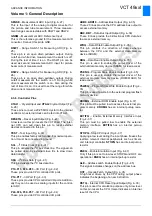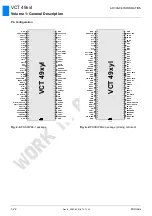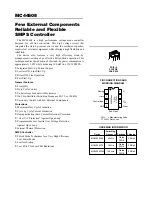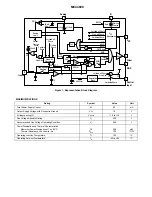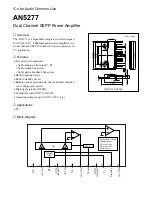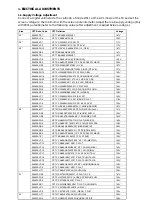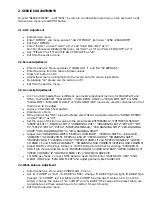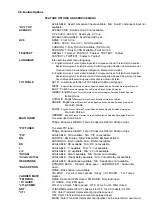
VCT 49xxI
ADVANCE INFORMATION
Volume 1: General Description
1-20
Dec. 6, 2002; 6251-573-1-1AI
Micronas
AOUT1 R/L
– Audio 1 Outputs (Fig. 4–11)
Output of the analog audio 1 signal. Connections to
these pins are intended to be AC coupled.
AOUT2 R/L
– Audio 2 Outputs (Fig. 4–11)
Output of the analog audio 2 signal. Connections to
these pins are intended to be AC coupled.
SPEAKER R/L
– Loudspeaker Outputs (Fig. 4–13)
Output of the loudspeaker signal. A 1 nF capacitor to
GND
must be connected to these pins. Connections to
these pins are intended to be AC-coupled.
Video Pins
VIN 1–11
−
Analog Video Input (Fig. 4–15)
These are the analog video inputs. A CVBS, S-VHS,
YCrCb or RGB/FB signal is converted using the luma,
chroma and component AD converters. The input sig-
nals must be AC-coupled by 100nF. In case of an ana-
log fast blank signal carrying alpha blending information
the input signal must be DC-coupled.
VOUT 1-3
−
Analog Video Output (Fig. 4–16)
The analog video inputs that are selected by the video
source select matrix are output at these pins.
RIN, GIN, BIN
−
Analog RGB Input (Fig. 4–17)
These pins are used to insert an external analog RGB
signal, e.g. from a SCART connector which can be
switched to the analog RGB outputs with the fast blank
signal. Separate brightness and contrast settings for
the external analog signals are provided.
FBIN
−
Fast Blank Input (Fig. 4–18)
This pin is used to switch the RGB outputs to the exter-
nal analog RGB inputs. The active level (low or high)
can be selected by software.
ROUT, GOUT, BOUT
−
Analog RGB Output (Fig. 4–
19)
These pins are the analog Red/Green/Blue outputs of
the back-end. The outputs are current sinks.
SVMOUT
−
Scan Velocity Modulation Output (Fig. 4–
19)
This output delivers the analog SVM signal. The D/A
converter is a current sink like the RGB D/A convert-
ers. At zero signal the output current is 50% of the
maximum output current.
VRD
−
DAC Reference Decoupling (Fig. 4–20)
Via this pin the RGB-DAC reference voltage is decou-
pled by an external capacitor. The DAC output cur-
rents depend on this voltage, therefore a pulldown
transistor can be used to shut off all beam currents. A
decoupling capacitor of 4.7
µ
F in parallel to 100 nF
(low inductance) is required.
XREF
−
DAC Current Reference (Fig. 4–20)
External reference resistor for DAC output currents,
typical 10 k
Ω
to adjust the output current of the D/A
converters. (see recommended operating conditions).
This resistor has to be connected to ground as closely
as possible to the pin.
4.3.5. CRT Pins
VPROT
−
Vertical Protection Input (Fig. 4–22)
The vertical protection circuitry prevents the picture
tube from burn-in in the event of a malfunction of the
vertical deflection stage. If the peak-to-peak value of
the sawtooth signal from the vertical deflection stage is
too small, the RGB output signals are blanked.
SAFETY
−
Safety Input (Fig. 4–22)
This input has two thresholds. A signal between the
lower and upper threshold means normal function. A
signal below the lower threshold or above the upper
threshold is detected as malfunction and the RGB sig-
nals will be blanked.
HOUT
−
Horizontal Drive Output (Fig. 4–21)
This open source output supplies the drive pulse for
the horizontal output stage. An external pulldown
resistor has to be used. The polarity and gating with
the flyback pulse are selectable by software.
HFLB
−
Horizontal Flyback Input (Fig. 4–22)
Via this pin the horizontal flyback pulse is supplied to
the VCT 49xxI.
VERT+, VERT
− −
Vertical Sawtooth Output (Fig. 4–23)
These pins supply the symmetrical drive signal for the
vertical output stage. The drive signal is generated
with 15-bit precision. The analog voltage is generated
by a 4 bit current-DAC with an external resistor of
6.8 k
Ω
and uses digital noise shaping.
EW
−
East-West Parabola Output (Fig. 4–24)
This pin supplies the parabola signal for the East-West
correction. The drive signal is generated with 15 bit
precision. The analog voltage is generated by a 4 bit
current-DAC with an external resistor of 6.8 k
Ω
and
uses digital noise shaping.
PWMV
−
PWM Vertical Output (Fig. 4–35)
This pin provides an adjustable vertical parabola with 7
bit resolution and appr. 79.4 kHz PWM frequency.
DFVBL
−
Dynamic Focus Vertical Blanking (Fig. 4–35)
This pin supplies the blank pulse for dynamic focus
during vertival blanking period or a free programmable
horizontal pulse for horizontal dynamic focus genera-
tion.
















